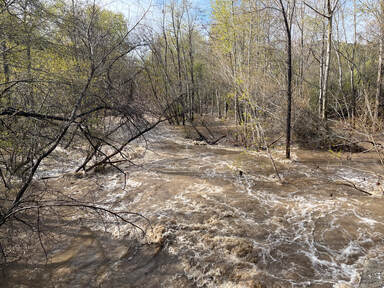 The Monterey region has experienced an unusually wet winter, with recent heavy rains causing both positive and negative impacts on the region. Abundant rainfall has led to a rebound in fish populations, reduced wildfire risks, with promised benefits to the region’s aquifer storage and recovery (ASR) system. However, the rains have also resulted in localized flooding and infrastructure damage. This winter’s increased rainfall has led to improvements in anadromous populations. The wet conditions have enabled salmon and trout to migrate upriver to spawn, providing an essential boost to their numbers. This resurgence will not only benefit the ecosystem but also the California salmon fishing industry (source: ABC10). Steve Park of the Carmel River Steelhead Association explained that this also helped the Carmel River watershed’s steelhead populations. However, even though the improved river flow supports the local steelhead population, their three year cycle between the ocean and the river means the wet conditions need to be sustained for several years in order to show longstanding improvements to the populations within our watershed. Another additional benefit of the heavy rains is that they have stimulated vegetation growth. While the abundant precipitation has led to more moisture in vegetation and soil, creating a less flammable environment (source: Fast Company), the rapid growth of new vegetation could also provide additional fuel for fires in the future. This shows how managing wildfires is complex and can be affected by various factors. Additionally, the heavy rains have positively impacted aquifer storage and recovery (ASR) in the Monterey area. ASR involves capturing excess surface water during wet periods, like this winter, and injecting it into the Seaside Groundwater Basin. This process improves water supply reliability and reduces dependence on imported water for the region (source: MPRPD). Jon Lear, Water Resources Division Manager with the Monterey Peninsula Water Management District, reports 1,341 Acre Feet of water have been injected as part of ASR this year. This included 13 Acre Feet per day at the two Santa Margarita Wells, which is the maximum permitted for the region. Two new wells will be built soon, which will allow for additional water to be recovered from future rain events. However, these historic rains have not come without damaging impacts. Local reports state the region has received well above the average annual rainfall, with some areas experiencing up to 150% of their typical precipitation (source: MC Weekly). Localized flooding and damage to infrastructure have been reported across the region. Roads and bridges have been affected, and some residents have been forced to evacuate their homes due to the risk of landslides. As the rains subside, communities and authorities must address these issues and prepare for future extreme weather events.
1 Comment
giggity giggity giggity giggity giggity giggity giggity giggity giggity giggity giggity giggity giggity giggity giggity giggity giggity giggity giggity giggity giggity giggity giggity giggity giggity giggity giggity giggity
11/13/2023 08:49:10 am
giggity giggity giggity giggity giggity giggity giggity giggity giggity giggity giggity giggity giggity giggity giggity giggity giggity giggity giggity giggity giggity giggity
Reply
Leave a Reply. |
Carmel River Watershed Conservancy, 225 Crossroads Blvd Suite 322, Carmel, California 93923, United States
[email protected]
[email protected]
Header Images © Luciane Coletti. All rights reserved.
© Carmel River Watershed Conservancy. All rights reserved.
© Carmel River Watershed Conservancy. All rights reserved.

 RSS Feed
RSS Feed
